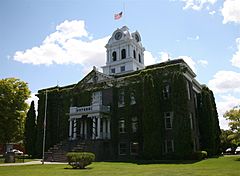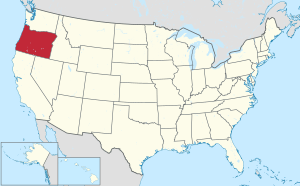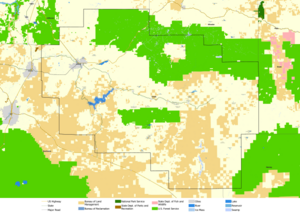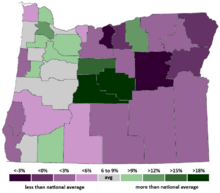Crook County, Oregon facts for kids
Quick facts for kids
Crook County
|
|
|---|---|

Crook County Courthouse in Prineville
|
|

Location within the U.S. state of Oregon
|
|
 Oregon's location within the U.S. |
|
| Country | |
| State | |
| Founded | October 24, 1882 |
| Named for | George Crook |
| Seat | Prineville |
| Largest city | Prineville |
| Area | |
| • Total | 2,987 sq mi (7,740 km2) |
| • Land | 2,979 sq mi (7,720 km2) |
| • Water | 8.2 sq mi (21 km2) 0.3%% |
| Population
(2020)
|
|
| • Total | 24,738 |
| • Estimate
(2023)
|
26,952 |
| • Density | 7.0/sq mi (2.7/km2) |
| Time zone | UTC−8 (Pacific) |
| • Summer (DST) | UTC−7 (PDT) |
| Congressional district | 2nd |
Crook County is one of the 36 counties in the U.S. state of Oregon. As of the 2020 census, the population was 24,738. The county seat is Prineville. The county is named after George Crook, a U.S. Army officer who served in the American Civil War and various Indian Wars.
Crook County comprises the Prineville, OR Micropolitan Statistical Area, which is included in the Bend—Prineville, OR Combined Statistical Area.
Contents
History

Crook County was established on October 9, 1882, by an act of the Oregon State Legislature. The county was named after General George Crook, a veteran of various battles against the indigenous peoples of Eastern Oregon in the middle of the 19th century. The county was formed from territory formerly part of Wasco County, including the hilly region where the foothills of the Blue Mountains intersect the Cascade Mountain Range.
Access into the region at first was difficult, which discouraged settlement. The first effort to develop routes into the area was in 1862 when a supply train with cattle crossed the Scott Trail. This was also the first group of non-natives to spend the winter in central Oregon. The discovery and development of the Santiam Pass in the 1860s improved access into the area.
Prineville, incorporated in 1880 and then the only incorporated town in the county, was established as the county seat. This decision was confirmed by the voters in the 1884 general election.
From the start cattle ranching has been one of the primary industries of the county, with huge herds grazing the countryside from the 1880s. Farming was also developed in certain valley regions friendly to agriculture.
Logging in the Ochoco Mountains and the timber mills that accompanied also greatly contributed to the economic and population growth of the county. The first recorded mention of a sawmill was made by George Barnes, speaking about the Swartz sawmill on Mill Creek, circa 1867.
Geography
The county is located in the geographic center of Oregon. According to the U.S. Census Bureau, the county has a total area of 2,987 square miles (7,740 km2), of which 2,979 square miles (7,720 km2) is land and 8.2 square miles (21 km2) (0.3%) is water. The largest body of water in Crook County is the Prineville Reservoir. The county has been reduced from its original size of 8,600 square miles (22,000 km2) by the creation of Jefferson County in 1914 and Deschutes County in 1916. The present boundaries were established in 1927.
The oldest geological formation in Oregon is in the southeastern corner of Crook County, near its boundary with Grant County. This formation is an outcropping of Devonian limestone created from a larger reef when most of Oregon was covered by water.
Adjacent counties
- Jefferson County - north
- Wheeler County - north
- Grant County - east
- Harney County - southeast
- Deschutes County - southwest
National protected area
- Ochoco National Forest (part)
Demographics
| Historical population | |||
|---|---|---|---|
| Census | Pop. | %± | |
| 1890 | 3,244 | — | |
| 1900 | 3,964 | 22.2% | |
| 1910 | 9,315 | 135.0% | |
| 1920 | 3,424 | −63.2% | |
| 1930 | 3,336 | −2.6% | |
| 1940 | 5,533 | 65.9% | |
| 1950 | 8,991 | 62.5% | |
| 1960 | 9,430 | 4.9% | |
| 1970 | 9,985 | 5.9% | |
| 1980 | 13,091 | 31.1% | |
| 1990 | 14,111 | 7.8% | |
| 2000 | 19,182 | 35.9% | |
| 2010 | 20,978 | 9.4% | |
| 2020 | 24,738 | 17.9% | |
| 2023 (est.) | 26,952 | 28.5% | |
| U.S. Decennial Census 1790–1960 1900–1990 1990–2000 2010–2020 |
|||
2010 census
As of the 2010 census, there were 20,978 people, 8,558 households, and 6,025 families living in the county. The population density was 7.0 inhabitants per square mile (2.7/km2). There were 10,202 housing units at an average density of 3.4 units per square mile (1.3 units/km2). The racial makeup of the county was 92.7% white, 1.4% American Indian, 0.5% Asian, 0.2% black or African American, 0.1% Pacific islander, 3.2% from other races, and 2.0% from two or more races. Those of Hispanic or Latino origin made up 7.0% of the population. In terms of ancestry, 20.7% were German, 14.6% were English, 12.6% were Irish, and 6.2% were American.
Of the 8,558 households, 27.7% had children under the age of 18 living with them, 57.1% were married couples living together, 9.0% had a female householder with no husband present, 29.6% were non-families, and 24.1% of all households were made up of individuals. The average household size was 2.42 and the average family size was 2.84. The median age was 45.6 years.
The median income for a household in the county was $46,059 and the median income for a family was $52,477. Males had a median income of $41,375 versus $29,545 for females. The per capita income for the county was $22,275. About 10.6% of families and 14.0% of the population were below the poverty line, including 26.1% of those under age 18 and 4.0% of those age 65 or over.
Communities
City
- Prineville (county seat)
Census-designated places
- Juniper Canyon
- Ochoco West
- Prineville Lake Acres
Other unincorporated communities
- Forest Crossing
- Lone Pine
- O'Neil
- Paulina
- Post
- Powell Butte
- Roberts
- Suplee
Economy
Forest products, agriculture, livestock raising and recreation/tourism services constitute Crook County's total economy. Agriculture is supported by the development of irrigation districts, which permits the raising of hay, grain, mint, potatoes, and seed. Range and forest lands allow grazing for a sizable livestock industry. The Ochoco National Forest's stand of ponderosa pine is the main source of lumber. Tourism and recreation help round out the economy. Thousands of hunters, fishers, boaters, sightseers and rockhounds are annual visitors to its streams, reservoirs and the Ochoco Mountains. The Prineville Chamber of Commerce provides access to over 1,000 acres (4.0 km2) of mining claims to rockhounds, who can dig for free agates, limb casts, jasper and thundereggs.
See also
 In Spanish: Condado de Crook (Oregón) para niños
In Spanish: Condado de Crook (Oregón) para niños



